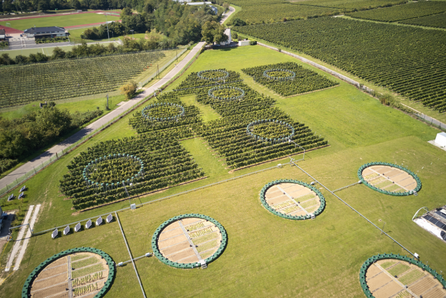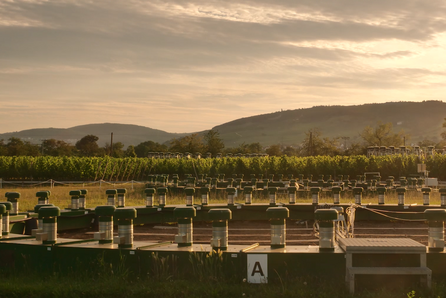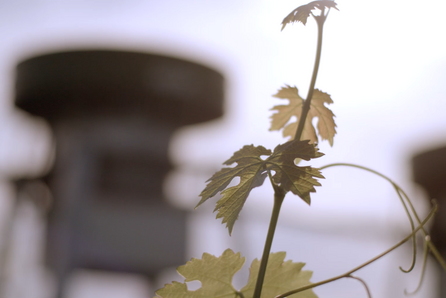Geisenheim FACE Experiments: An outlook on our atmospheric future (FACE = Free Air Carbon Dioxide (CO2) Enrichment)
- Scientists working at Geisenheim FACE facilities for special crops are examining the effects of increased CO2 concentration on cultivation, physiology, pest infestation and product quality of grapevines and vegetables.
- Grapevine-FACE is cultivating Riesling and Cabernet Sauvignon.
- Vegetable-FACE is examining the effects of full and limited water supply on cultivated plants such as spinach, radishes and cucumbers
- Individual sub-projects are looking into greenhouse gas emissions from soils, physiology and yield, interactions between plants and pests as well as changes to substances and product quality in grapevines and vegetables under increased CO2 concentration.
Together with our partners from the Justus-Liebig University Gießen, the Philipps University Marburg, the Max-Planck Institute for Terrestrial Microbiology in Marburg and the "Landesamt für Umwelt und Geologie" (Hessen Conservation, Environment and Geology Institute) we aim to establish a unique worldwide outdoor research infrastructure. The initiative is supported by the Hessen region as part of its LOEWE excellence research-funding program.
Related Press Releases
In this sub-project, climate-relevant greenhouse gas emissions (N2O, CO2, CH4) from soils used for viticulture and horticulture are examined under increased CO2 concentrations. The project also aims to collect data on the effects of soil cultivation, irrigation, fertilization and extreme climate events such as heavy rainfall on the intensity of greenhouse gas emissions. Gas analyses with photoacoustic spectroscopy are carried out for data collection, which will be used for improving existing ecosystem models.
This sub-project also examines the effects of increased CO2 concentration on phenology and physiological processes as well as fruit and internal substance development of the Riesling and Cabernet Sauvignon grape varieties. In the course of the vegetation period, data on the vines’ physiological status is collected using non-invasive measurements of greenhouse gas changes and chlorophyll fluorescence. Alongside yield parameters, berry quantity, quality, and wine substances are analyzed.
This sub-project examines the effects of increased atmospheric CO2 concentrations combined with water stress on phenology and yield of field vegetables. The analysis aims to examine the effects of interactions between the chosen environmental factors on water use efficiency and yield processes, using (1) experimental data and (2) a model that combines plant architecture and growth models.
In this part of the project the effects of increased atmospheric CO2 concentration and reduced water supply on product quality of field vegetables (spinach, radishes and cucumbers) are being examined. Substance groups (minerals, phenols) are analyzed with regard to changes in their composition and concentration. We are also planning to carry out experiments on sensor technologies and density of harvest yields.
In this sub-project possible effects of increased CO2 concentration on interactions between vines and two economically damaging pests (plasmopara viticola, pathogen carried by the downey mildew and Lobesia botrana, the European grapevine moth) are being examined. To achieve results, data on developmental biology, or more specifically, pathogenesis of the pests and modifications of pest-relevant anatomic characteristics of the vine are collected. On a molecular level, modifications of levels of relevant defence gene expressions of the host plant are being analyzed.
Higher CO2 levels causing modifications of the N2 supply in soils, and of the uptake, transportation and storage of nitrogen compounds within the plant can have a major influence on wine quality. This sub-project deals with possible strategies for ensuring sufficient nitrogen supply in order to compensate for the negative effects of higher CO2 levels. To develop such strategies scientists are examining the qualitative composition of amino acids in the generative and vegetative parts of the vine and are looking into modifications of the activity of specific enzymes within the vine.
Minister for climate protection Priska Hinz opens the closing event of the FACE2FACE cooperative research project at Hochschule Geisenheim University
FACE2FACE is a research project funded by the LOEWE Hessen Excellence-Initiative. The project’s scientists are cultivating plants in an atmosphere rich in CO2 to simulate the increased CO2 concentrations seen in climate change. There are only 20 of the high complex FACE facilities worldwide, with three of them based in Gießen and Geisenheim. This is an exceptional cooperative project between four partners : The Justus-Liebig University Gießen, Hochschule Geisenheim University, the Max-Planck Institute for Terrestrial Microbiology in Marburg and the Hessen Conservation, Environment and Geology Institute in Wiesbaden.
From January 2014 to fall 2017, scientists working for the Loewe FACE2FACE program studied relevant agricultural ecology systems in Hessen under climate change conditions: Grasslands in Gießen, viticulture and field vegetable production in Geisenheim. Given that we can expect increasing CO2 concentrations until 2050, the scientists wanted to focus on possible effects on cultivation processes. Since the beginning of the industrial age, the CO2 concentration has increased from 280 ppm (parts per million) to over 400 ppm. We are expecting 480 ppm by 2050. This development has no precedent in data from previous centuries. However, CO2 is not only a potent greenhouse gas, it also promotes plant growth via photosynthesis.
The FACE systems (Free Air CO2 Enrichment) at both sites increased CO2 in the atmosphere. The site in Geisenheim (Vineyard FACE; in operation since 2014) and Gießen (GiFACE or Giessen Grassland FACE; in operation since 1998) both have a diameter of 8 meters, while Geisenheim's second FACE site is 12 meters in diameter. The field vegetable production site, which is not yet ready for use, also measures 12 metres in diameter. At each site, three circular areas were enriched with CO2 while three control circles of the same surface area enabled effects to be monitored.
The FACE2FACE project focused on examining the effects, mechanisms and feedback of increased CO2 concentrations and other climatic variables caused by climate change. They analyzed the effects of low water supply and warming on climate-relevant emissions from soils, microbial changes in soils and plant surfaces, effects on animal pests and fungal pathogens, as well as physiological and substance-related reactions in agricultural crops.
FACE2FACE scientists gained interesting insights into the "black box" of our CO2 -rich future. Some of the results corresponded to our expectations, while some of them were rather surprising.
Gießen Greenland:
- As expected, an increase in CO2 concentration increases the surface biomass yield by 15 percent on average. What we did not expect was for the fertilization effect to appear primarily when it was neither too cold, too dry, too humid nor too cold. Up until that point, we believed that an increase in the CO2 concentration would help to get through dry periods and heat waves.
- While higher CO2 levels did not have a negative effect on Grassland Biodiversity, the soil seed bank showed an increased seed density in the first ten centimeters below the surface - particularly the varieties with generative (non-vegetative) reproduction and those whose seeds remain viable for a longer period of time. The experiments also found that microbes on leaf surfaces of the main grassland varieties changed too.
- One question that remains unanswered is why there was a slight but systematic change in soil temperatures in an increased CO2 atmosphere: In summer, soil temperatures were relatively cooler in the increased CO2 atmosphere than in the control-areas.
- The increased CO2 concentration had slightly negative effects on nitrogen levels, an important plant nutrient. As expected, the higher CO2 level led to a decrease in nitrogen in the plant tissue and, as a consequence, food quality, for example for ruminants, decreased, with lower levels of raw proteins. In theory, ruminants would have to eat more to balance out the drop in raw proteins, but this could lead to an increase in methane emissions (not studied by the project).
- An increased CO2 level changed the microbial processes within the grassland soils: Nitrous oxide output (N2O) doubled in the course of the experiment. Scientists discovered that microbial communities in root systems as well as the soil in general also underwent changes.
- Increased nitrous gas emissions, modified CO2 fertilization effects under extreme climate conditions, and higher soil temperatures in winter might foster a decrease in soil humus and all contribute to the self-reinforcing feedback effects we fear. The higher CO2 levels set off changes in the grassland, automatically leading to more greenhouse gas emissions and therefore causing further warming up. “Input plus outcome” does not automatically lead to CO2 extraction from atmosphere.
Geisenheim Vineyard-FACE Experiment:
- It was only in 2014 that the experiment started in Geisenheim, therefore the first crop of grapes with the flower primordia formed under increased CO2 conditions are from 2015. Two grape varieties are being cultivated in the research areas: Riesling, the most popular white wine variety in the Rhinegau area and Germany as a whole, and Cabernet Sauvignon, the second to third most common red wine variety in the world. The first years of the experiment were mostly ‘extreme years’ with regard to the climate conditions: 2015 was the warmest year on record in Geisenheim and Germany. In 2016, however, January to June had the highest precipitation recorded in Geisenheim since 1885, making generalization impossible.
- From 2014 to 2017, the phenological development of both grape varieties was not influenced by an increase in CO2.As expected, photosynthesis and biomass production of both grape varieties increased significantly in all vegetation periods (2014 to 2017). Contrary to current findings, transpiration (water consumption) of both grape varieties increased despite higher CO2 levels. Water use efficiency (relation between photosynthesis and transpiration) increased for both grape varieties despite higher CO2 levels.
- Both grape varieties showed an increase in yield from single grape vines for 2014, 2015 and 2016 under increased CO2. It was especially the grape structure that changed, while the number of grapes per vine stayed constant. Length and width of the stems as well as grape weight and the amount of berries increased, with a higher proportion of bigger grapes.
- The amount of sugar that both grape varieties contained only varied slightly at grape maturity under increased CO2 concentration. In 2015, malic acid in Riesling musts increased under higher CO2 levels. We can therefore say that a higher CO2 level does not have a significant effect on the quality of the substances in the musts of either grape variety or on the overall quality of the wines.
- The experiment must continue for a few more years in order to yield results on effects on wine quality. So far, there have not been any differences.
- Geisenheim Vineyard-FACE is also examining interactions between vines under higher CO2 and current CO2 levels and the fungal pathogen Plasmophara viticola(downey mildew) and the insect pest Lobesia botrana(European grapevine moth). Vines show a significantly higher gene expression when infected with downey mildew under higher CO2 than under current levels. Most of the reactions observed are part of metabolic processes that play an important role in the synthesis of plant secondary metabolites or in defense reactions (e.g., stilbenes or cell wall proteins). European grapevine moth populations adapt physiologicallyto higher CO2 concentrations and show modifications in their developmental biology after several generations.
- Contrary to Gießen grassland, vineyard soils under increased CO2have not yet shown an increase in nitrous oxide.
Experiments on field vegetable production (spinach, radishes, cucumbers) could only be carried out on a limited scale. The experiment only focused on reactions to modified water supply without examining the effects of a higher CO2 concentration. Only a slight water supply reduction had significant effects on the substances influencing product quality with regard to the dry mass (e.g., malic acid and phosphorous).


![[Translate to English:] FACE](/fileadmin/_processed_/3/a/csm_FACE_Bildquelle_Dieter_Ettingshaus_HGU_a29c9fbfb5.jpg)





